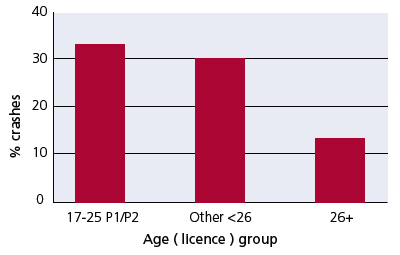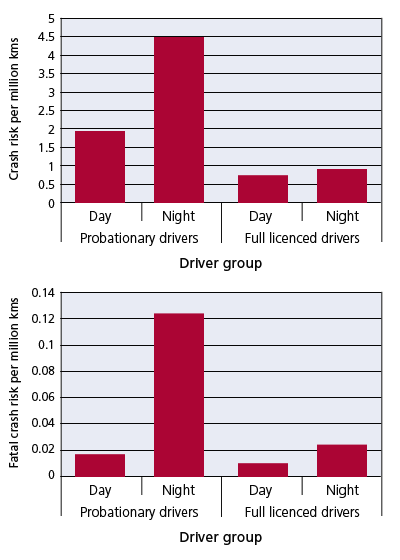Should young drivers be restricted from driving at night?
The highest risk of death for young drivers involved in road crashes occurs during the night-time hours; especially nearing midnight and into the early morning hours, and during these times on weekends.
All drivers have increased crash risk during night-time hours, but the risk is greater for the inexperienced young driver. Reasons for increased crash risk at night include poorer visual information, increased likelihood of drivers on the road impaired by fatigue and alcohol, more risk taking and more “recreational” driving – which also includes more likelihood of peer passengers for young drivers. Young drivers also drive more at night compared to adult drivers, and at night they are less likely to use their seat belt increasing their injury risk.
A study in Western Australia has shown that drivers on their Provisional licence are more likely to have a crash at night than non-Provisional licence holders. Similar patterns have been reported in New South Wales and Victoria.

Figure 1 NSW driver fatal crashes between 10pm-5am as a percentage of total by age group 2001-2003 (RTA, 2004)

Figure 2 Victorian driver crash and fatal crash rates during the day (6am to 10pm) and night (10pm to 6am) by licence type (VicRoads, 2005)
Support for restrictions
New Zealand and parts of the United States and Canada have had night-time driving restrictions in place for several years. Evaluations have shown these restrictions have reduced young driver crashes by between 17 and 47%, including up to half of all crashes at night. Young driver deaths and injuries have also reduced, by between one-quarter to one-third.
Different jurisdictions have introduced different time periods for the restrictions from the very brief (1 – 5 am) to very long (sunset to sunrise in one U.S. state). The strongest graduated driving licensing systems are those in which a night-time restriction applies prior to midnight, with 9 or 10pm recommended by the U.S. Insurance Institute for Highway Safety.
Potential issues
There can sometimes be real or perceived community resistance to the implementation of night-time restrictions, usually based on concerns regarding availability of alternative transport options or safety issues if young people choose to walk home long distances late at night. While this can be a concern, particularly in areas with limited public transport options, this has generally not been realised in jurisdictions where night-time restrictions are in place. Research finds young drivers report being able to adapt to the restrictions and do the activities they want by getting a lift or by arriving earlier at their destination.
To be effective, it is important that there is good compliance with night-time restrictions and this generally requires strong parental and police enforcement. Some studies have found up to 15% of young drivers have reported disobeying the night-time restriction; however, most report violations only rarely rather than all the time.
Similar to passenger restrictions, the main focus of night-time restrictions is to reduce high-risk recreational driving, including driving without a particular destination in mind – a more common scenario for younger than older drivers. Most jurisdictions that currently have restrictions in place allow exemptions for “purposeful driving” such as for study, work or family activities, and medical/emergency and religious exemptions can also apply. Typically these do not need prior registration, rather the young driver is asked to show proof of trip purpose at the time of the trip. Pre-registration can pose difficulties for licensing authorities, police and young drivers in rural and remote communities where access to places of registration can be limited and there is no research yet to indicate whether this is more effective.
It is also important to note that there should be no night-time restriction during the Learner phase of licensing as it is important that Learner drivers practice under these conditions when appropriately supervised and when crash risk is at its lowest.
Factbase recommendations
Night-time driving restrictions are effective and should apply to first-year Provisional drivers from at least 11pm to 5am, with administrative exceptions.
References
Adams C, Adams C. Probationary and non-probationary drivers’ nighttime crashes in Western Australia, 1996-2000. Journal of Safety Research. 2005;36(1):33-37.
Begg DJ, Langley JD, Reeder AI, Chalmers DJ. The New Zealand graduated driver licensing system: teenagers’ attitudes towards and experiences with this car driver licensing system. Injury Prevention. Sep 1995;1(3):177-181.
Begg DJ, Stephenson S, Alsop J, Langley J. Impact of graduated driver licensing restrictions on crashes involving young drivers in New Zealand. Injury Prevention. Dec 2001;7(4):292-296.
Chen LH, Baker SP, Li G, Chen L-H, Baker SP, Li G. Graduated driver licensing programs and fatal crashes of 16-year-old drivers: a national evaluation. Pediatrics. Jul 2006;118(1):56-62.
Clarke DD, Ward P, Bartle C, et al. Young driver accidents in the UK: the influence of age, experience, and time of day. Accident Analysis and Prevention. Sep 2006;38(5):871-878.
Goodwin AH, Foss RD, Goodwin AH, Foss RD. Graduated driver licensing restrictions: awareness, compliance, and enforcement in North Carolina. Journal of Safety Research. 2004;35(4):367-374.
Hartling L, Wiebe N, Russell K, Petruk J, Spinola C, Klassen TP. Graduated driver licensing for reducing motor vehicle crashes among young drivers. Cochrane Database of Systematic Reviews. 2004(2):CD003300.
Insurance Institute for Highway Safety. US licensing systems for young drivers. Washington DC; 2009 [available at: http://www.iihs.org/laws/pdf/us_licensing_systems.pdf].
Lin ML, Fearn KT. The provisional license: nighttime and passenger restrictions–a literature review. Journal of Safety Research. Jan 2003;34(1):51-61.
Masten SV, Hagge RA. Evaluation of California’s graduated driver licensing program. Journal of Safety Research. 2004;35(5):523-535.
Mayhew DR, Simpson HM, Ferguson SA, Williams AF. Graduated licensing in Nova Scotia: A survey of teenagers and parents. Journal of Traffic Medicine. 1998;26:37-44.
McKay MP, Coben JH, Larkin GL, et al. Attitudes of teenagers and their parents to Pennsylvania’s graduated driver licensing system. Traffic Injury Prevention. 2008;9(3):217-223.
Rice TM, Peek-Asa C, Kraus JF. Nighttime driving, passenger transport, and injury crash rates of young drivers. Injury Prevention. Sep 2003;9(3):245-250.
Australian Transport Safety Bureau. Road deaths Australia: 2007 statistical summary. Commonwealth of Australia; 2008 [available at: http://www.infrastructure.gov.au/roads/safety/publications/2008/pdf/Ann_Stats_2007.pdf].
Roads and Traffic Authority of New South Wales. Improving safety for young drivers: an options paper for community comment. RTA, Sydney NSW; 2004.
Senserrick T, Haworth N. Review of literature regarding national and international young driver training, licensing and regulatory systems. MUARC Report 239. Monash University Accident Research Centre, Clayton VIC; 2005.
Senserrick T, Whelan M. Graduated driver licensing: Effectiveness of systems and individual components. MUARC Report 209. Monash University Accident Research Centre, Clayton VIC; 2003.
VicRoads. Young driver safety and graduated driver licensing: discussion paper. Kew, VIC, August: VicRoads; 2005.
Williams AF. Contribution of the components of graduated licensing to crash reductions. Journal of Safety Research. 2007; 38: 177-184.
Williams AF, Nelson LA, Leaf WA, Williams AF, Nelson LA, Leaf WA. Responses of teenagers and their parents to California’s graduated licensing system. Accident Analysis and Prevention. Nov 2002;34(6):835-842.
Williams AF, Preusser DF. Night driving restrictions for youthful drivers: a literature review and commentary. Journal of Public Health Policy. 1997;18(3):334-345.
